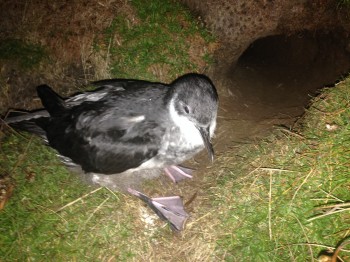Britta Hardesty (CSIRO Oceans and Atmosphere Flagship, Hobart, Tasmania, Australia) and colleagues have published early view in the journal Methods in Ecology and Evolution on detecting plastic pollution in seabirds via analysis of their preen gland oil. Species studied included the Short-tailed Puffinus tenuirostris and Wedge-tailed P. pacificus Shearwaters. Flesh-footed Shearwater, photograph by Barry Baker
Flesh-footed Shearwater, photograph by Barry Baker
The paper’s summary follows:
- Plastic pollution is a long-standing ubiquitous issue. Global use of plastics is continuing to rise, and there is increasing interest in understanding the prevalence and risk associated with exposure of wildlife to plastics, particularly in the marine environment.
- In order To facilitate an assessment of ingestion of plastics in seabird populations, we developed a minimally invasive tool that allows for detection of exposure to plastics.
- Using a simple swabbing technique in which the waxy preen oil is expressed from the uropygial gland of birds, we successfully tested for the presence of three common plasticizers: dimethyl, dibutyl and diethylhexyl phthalate [dimethyl phthalate, dibutyl phthalate and bis(2-ethylhexyl)-phthalate, respectively]. These plasticizers are prevalent in the manufacturing of plastic end-user items which often end up in the marine environment.
- Using gas chromatography–mass spectrometry and protocols to reduce background contamination, we were confidently able to detect targeted plasticizers at low levels.
- The method described has broad applicability for detecting plastics exposure in wildlife at individual, population and species levels. Furthermore, the approach can be readily modified as needed to survey for plastics exposure in taxa other than seabirds.
- Applying the simple, minimally invasive approach we describe here is particularly appealing for detecting plastics exposure at population and species levels, it shows promise for quantification and it has no observed detrimental impacts to wildlife."
- Click here for a media report on the publication.
Reference:
Hardesty, B.D., Holdsworth, D., Revill, A.T. & Wilcox, C. 2014. A biochemical approach for identifying plastics exposure in live wildlife. Methods in Ecology and Evolution DOI: 10.1111/2041-210X.12277.
John Cooper, ACAP Information Officer, 13 November 2014

 English
English  Français
Français  Español
Español 


